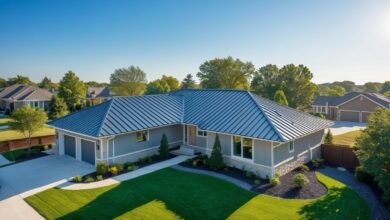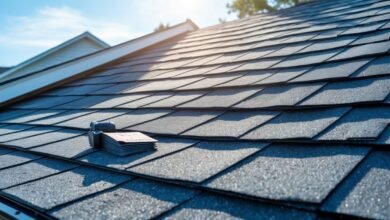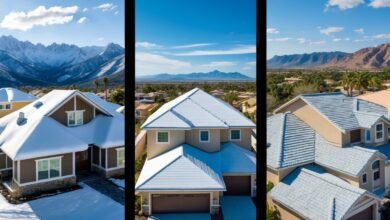Comparing Roofing Materials: Asphalt, Metal, Tile & More for Durable and Cost-Effective Choices

Choosing the right roofing material is an important decision that affects a home’s durability, cost, and appearance. Homeowners often consider asphalt, metal, and tile options, each with different benefits and drawbacks. The best roofing material depends on factors like budget, climate, and how long the roof needs to last.
Metal roofs are known for lasting 40 to 70 years or more and offer strong protection against fire and weather damage. Asphalt shingles are more affordable upfront but don’t last as long. Tile roofs provide a unique look and good durability but can be heavier and cost more. Knowing these basics helps guide the choice for a roof that fits both needs and style.
Understanding the key differences in performance, cost, and installation can help homeowners make a wise investment. This guide breaks down what to expect from common roofing materials so readers can pick the best fit for their home.
Key Takeways
- Durability and lifespan vary widely between roofing materials.
- Cost and installation needs are key factors in choosing a roof.
- Aesthetics and weather resistance impact the best roofing choice.
Overview of Major Roofing Materials

Choosing the right roofing material depends on factors like cost, durability, climate, and style preferences. Different materials offer various benefits and challenges, such as lifespan, maintenance, and energy efficiency.
Asphalt Shingles
Asphalt shingles are the most common roofing material in the U.S. They are affordable and relatively easy to install. Asphalt shingles come in various styles and colors, making them versatile for many home designs.
They generally last 20 to 30 years but may require more frequent replacement in extreme weather areas. Asphalt shingles can handle moderate weather, but they are not as durable as metal or tile roofs. Maintenance is low, but issues like curling or cracking can occur over time.
Metal Roofing
Metal roofing is becoming more popular for its durability and energy efficiency. Metal roofs can last 50 years or more. They reflect sunlight, which helps lower cooling costs in hot climates.
Metal roofing comes in various styles such as panels and shingles. It is fire-resistant and performs well in harsh weather. However, installation costs are higher than asphalt shingles. Metal roofs require less maintenance but can be noisy during rain or hail unless properly insulated.
Tile Roofing
Tile roofing includes clay and concrete tiles, known for their long life and aesthetic appeal. Clay tiles can last up to 50 years or more but are expensive, sometimes costing two to three times more than asphalt shingles.
Tile roofs are heavy, so the roof structure must support the weight. They are fire-resistant and excellent for hot climates due to their ability to keep homes cooler. Repair can be costly if tiles crack or break, but overall maintenance needs are low.
Wood Shingles and Shakes
Wood shingles and shakes offer a natural, rustic look. They are usually made from cedar, redwood, or pine. Both provide good insulation but require more upkeep than asphalt or metal.
Shingles are machine-cut and smooth, while shakes are hand-split and rougher. Wood roofs can last about 20 to 40 years if properly cared for. They are prone to rot, insects, and fire unless treated. Regular maintenance includes cleaning and sealing to protect the wood.
Composite and Synthetic Roofing
Composite roofing uses a mix of materials like plastic, rubber, and fiber to mimic natural materials such as wood or slate. Composite shingles are lighter and often cheaper than natural options.
These roofs can resist fire, insects, and rot better than wood. They usually last 30 to 50 years, depending on the product. Composite materials are easy to install and maintain. They provide more design flexibility and can match different home styles.
Other Options: Slate, Clay, and Recycled Materials
Slate roofs are very durable and can last over 100 years. They are heavy and expensive but valued for their natural beauty and fire resistance. Slate requires skilled installation.
Clay tiles, a type of tile roofing, are also long-lasting and energy-efficient. They perform well in hot climates but need strong roof support due to weight.
Recycled materials such as rubber or plastic shingles are eco-friendly alternatives. They mimic other roofing types and often cost less. These materials add sustainability but may vary in durability and lifespan.
Performance and Durability Comparison
Roofing materials differ in how long they last, how well they handle weather, and their physical properties. These factors affect quality, maintenance needs, and how soon a roof replacement might be necessary. Understanding these details helps in choosing the right roof for specific needs.
Longevity and Lifespan
Metal roofs typically last 40 to 70 years, depending on the type of metal and installation quality. This lifespan is much longer than asphalt roofing, which usually lasts 15 to 30 years. Tile roofs can last even longer, sometimes over 50 years, due to their strong, fire-resistant properties.
Asphalt shingles wear out faster because they are thinner and more prone to damage from wind and temperature changes. Tile and metal roofs require less frequent replacement, which can lower long-term costs despite higher upfront prices.
Weather Resistance and Quality
Metal roofs offer strong weather resistance, standing up well to heavy rain, snow, and high winds. They are also less likely to crack or warp. Asphalt roofing can be damaged by intense sun and freezing conditions, which may cause cracking or curling over time.
Tile roofs resist fire and can handle extreme heat well, but they are more fragile under impact, like from falling branches. Quality varies within materials, so proper installation and maintenance greatly affect how well they perform against weather.
Thickness, Weight, and UL Ratings
Asphalt shingles are thin and light, making them easy to install but less durable in storms. Metal roofing is thin but strong and lightweight compared to tile. Tile is much heavier, which may require additional roof support.
UL ratings measure a roof’s ability to resist impact and fire. Metal and tile roofs often have higher UL ratings for fire resistance. Asphalt shingles vary in UL ratings, with higher classes offering better protection but usually at a higher cost. Weight and thickness influence installation needs and structural demands.
Cost Considerations and Affordability
Choosing the right roofing material involves weighing the upfront cost against future expenses like maintenance and replacement. Some materials cost less initially but may lead to higher costs over time. Others demand a bigger investment at first but save money later due to durability and lower upkeep.
Initial Cost vs. Long-Term Investment
Asphalt shingles have the lowest initial cost, making them a popular choice for those on a tight budget. They are easy to install, which keeps labor costs down. On the other hand, metal and tile roofs cost more upfront but last significantly longer.
Investing more initially in metal or tile roofing can reduce the need for frequent repairs or early replacement. Over 20 to 30 years, these materials may prove to be more cost-effective despite higher initial prices.
Maintenance and Replacement Expenses
Maintenance needs vary widely by roofing type. Asphalt shingles require more regular inspection and repair because they can crack or lose granules. Metal roofs generally need less maintenance, resisting damage from weather better.
Tile roofs are durable but can break if walked on. Repairing tiles can be costly but is usually infrequent. Roof replacement costs depend on material lifespan; frequent replacement increases lifetime costs for lower-cost materials.
Cost-Effectiveness and Affordability
For budget-conscious homeowners, asphalt shingles offer the best balance of low initial cost and manageable maintenance. However, their shorter lifespan often means replacing the roof every 15-20 years.
Metal roofing, though more expensive initially, is cost-effective in the long run due to durability and minimal maintenance needs. Tile roofs are more costly upfront and less affordable but offer excellent longevity and aesthetic value, which can increase a home’s resale value.
| Material | Initial Cost | Lifespan (years) | Maintenance Cost | Replacement Frequency |
|---|---|---|---|---|
| Asphalt Shingles | Low ($) | 15-20 | Moderate | Every 15-20 years |
| Metal Roofing | High ($$) | 40-70 | Low | Rare |
| Tile Roofing | Very High ($$$) | 50-100+ | Low to Moderate | Rare |
Energy Efficiency and Insulation Properties
Roofing materials vary in how well they keep homes warm or cool and affect energy bills. Some materials block heat better, while others reflect sunlight to lower cooling costs. Understanding these traits helps homeowners pick roofs that fit their climate and budget.
Insulation Capabilities
Tile roofing offers strong insulation due to its thickness and ability to trap air, helping keep houses cooler in summer and warmer in winter. Asphalt shingles provide moderate insulation but are thinner, so they retain less heat.
Metal roofing is lightweight but has low natural insulation. However, metal roofs often come with reflective coatings that reduce heat absorption. Homeowners may need additional insulation under metal roofs to improve energy efficiency during cold months.
Energy Efficiency in Various Climates
In hot climates, metal roofing with reflective coatings can lower indoor temperatures by bouncing off sunlight, reducing the need for air conditioning. Tile roofs also work well by blocking heat.
In cooler climates, tile roofs and asphalt shingles can help retain warmth better than metal alone. Metal roofs need added insulation to prevent heat loss. The choice depends on balancing upfront cost with how much energy savings matter over time.
Aesthetic Appeal and Design Flexibility
Different roofing materials offer varying looks and options for homeowners. Some materials provide many colors and styles, while others fit specific architectural designs better.
Styles, Colors, and Curb Appeal
Asphalt shingles come in many shades and textures. They can mimic wood, slate, or tile, which helps boost curb appeal without high costs. Metal roofs often feature sleek, modern finishes or can imitate traditional shingles and tiles. Tile roofs usually have rich earth tones, giving homes a classic, timeless look.
Homeowners can choose from smooth, textured, or patterned surfaces. This variety makes it easier to match a roof to the home’s exterior color and style. The choice of materials and colors impacts how a home stands out in the neighborhood.
Adaptability to Different Roof Styles
Some roofing materials work better with specific roof shapes. Asphalt shingles are highly flexible and fit steep or simple roof pitches. Metal roofing adapts well to complex designs, including curved or low-pitched roofs. Tile roofing suits mainly stronger roof frames and is ideal for Mediterranean or Spanish-style homes.
Materials must align with both the design and support structure of the roof. Using the right material ensures durability and keeps the roof looking good over time. This adaptability helps homeowners maintain the visual harmony of their home’s architecture.
Installation, Professionals, and Choosing the Right Material
Proper installation is key to a roof’s performance and longevity. Hiring the right professional and understanding the installation process helps homeowners avoid costly mistakes. Choosing roofing materials depends on specific needs like weather resistance, upkeep, and budget.
Hiring a Qualified Roofing Contractor
A qualified roofing contractor ensures the job gets done right. Homeowners should look for licenses, insurance, and good reviews. Asking about experience with specific materials like asphalt or metal roofs is important.
A good contractor will provide a clear estimate and timeline. They should explain local building codes and warranty options. Checking if the contractor offers continuing education (CE) or training shows they stay updated on roofing standards.
Shingle Installation Guides
Shingle installation varies by material. Asphalt shingles require careful nailing and spacing to prevent leaks. Metal shingles need precise overlap and secure fasteners to avoid wind damage.
Following manufacturer instructions exactly is crucial for a strong roof. Installation guides often include details on underlayment, flashing, and ventilation. Proper installation reduces issues, such as water damage or early wear, helping the roof last longer.
Factors to Consider When Choosing Roofing Materials
Choosing roofing materials depends on several factors:
- Climate: Metal works well in rainy areas, tile in hot climates, and asphalt in moderate zones.
- Maintenance: Asphalt needs more upkeep, while metal and tile require less.
- Cost: Asphalt is usually cheaper upfront; tile and metal cost more but last longer.
- Home Style: Some materials fit certain architectural styles better.
Balancing these factors helps homeowners select a roof that meets their needs and budget.
Frequently Asked Questions
Different roofing materials vary in lifespan, cost, environmental impact, and durability. Installation processes and resistance to weather also differ widely among the options.
What are the key differences in lifespan between asphalt shingle and metal roofing?
Asphalt shingles typically last 20 to 30 years. Metal roofing lasts much longer, usually between 50 and 80 years.
The longer lifespan of metal can reduce how often a roof needs to be replaced.
How does the cost of tile roofing compare to traditional asphalt shingles?
Tile roofing is generally more expensive upfront than asphalt shingles.
Asphalt shingles are the most affordable option for most homeowners.
What are the environmental impacts of the different roofing materials available on the market?
Metal roofs are often recyclable and can lower energy costs by reflecting heat.
Asphalt shingles have a higher environmental cost because of petroleum use and limited recyclability.
Tile roofs are made from natural materials like clay, but production and transport increase their carbon footprint.
Can metal roofing be a more cost-effective option in the long term despite initial higher costs?
Yes. Metal roofing’s long lifespan and low maintenance can make it less expensive over time despite higher upfront costs.
Energy savings from heat reflection also add to its cost-effectiveness.
What roofing materials offer the best resistance to extreme weather conditions?
Metal and tile roofs are better at withstanding high winds, heavy rain, and hail.
Asphalt shingles can be more vulnerable to damage from harsh weather.
How does the installation complexity vary between asphalt, metal, and tile roofing?
Asphalt shingles are the easiest and fastest to install.
Metal roofing installation is more complex and requires specialized skills.
Tile roofing is the most labor-intensive and can take longer due to the weight and handling care needed.




